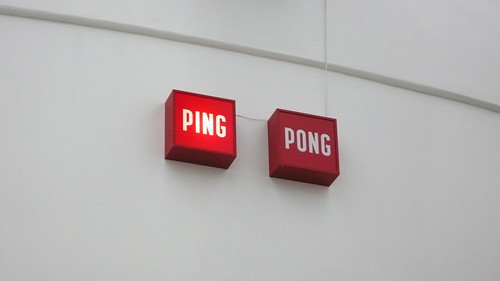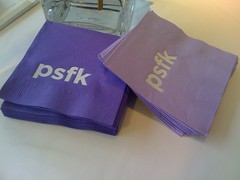 (I've been horrible at keeping up with a blogging routine lately, but that's a subject for a later post.) I was recently asked over email what I thought could be a potential "Twitter killer" as well as an interesting way Twitter is being used. Thought I'd share my off-the-top-of-my-head response:Potential Twitter killer:Lack of communityTwitter as a company has stated in the past that they view themselves as a "communications utility" and not a community. This is an unfortunate and potentially poisonous viewpoint to try and maintain. My guess is that Twitter wanted to view themselves as a utility to further propagate the idea that they want to scale to a huge size. Again, this is unfortunate as Flickr is a prime example of a massive web service that is known for scaling not only their web framework but their community as well. Flickr has proven over time that it can maintain a sense of community at a large scale (remember, they serve about 35,000 photos a *second*) by truly thinking about every user experience despite it sometimes making their heads hurt. Basic psychology shows that people connect more positively and interact more when they share common things with a group. If Twitter gets its wish and there is no longer a sense of community, then what motivation do users have to connect via Twitter than any other utility or service? Twitter works because the people you care about are into it, not because it's really necessary for your boss to know what you had for lunch on a public webpage.Interesting way people are using Twitter:Location Based Interaction and DatingTypically when people talk about interesting ways Twitter is being used, it's on this grandiose scale of "look how my business is profiting from being social and spreading awareness". Ok, that's already been done, boring. When you live in the same city as others that you have mutual connections with on Twitter, it's a great platform for spontaneous meetups, dates, and occasionally meeting new people. The new form of dating is almost this passive, cheesy situation like yawning to put your arm around someone during a movie. The first ping involves someone saying something like they're hungry, the returning pong suggest a location, and before you know it, there's a rallying ping pong of Twitter replies to make an IRL (in real life) event happen.
(I've been horrible at keeping up with a blogging routine lately, but that's a subject for a later post.) I was recently asked over email what I thought could be a potential "Twitter killer" as well as an interesting way Twitter is being used. Thought I'd share my off-the-top-of-my-head response:Potential Twitter killer:Lack of communityTwitter as a company has stated in the past that they view themselves as a "communications utility" and not a community. This is an unfortunate and potentially poisonous viewpoint to try and maintain. My guess is that Twitter wanted to view themselves as a utility to further propagate the idea that they want to scale to a huge size. Again, this is unfortunate as Flickr is a prime example of a massive web service that is known for scaling not only their web framework but their community as well. Flickr has proven over time that it can maintain a sense of community at a large scale (remember, they serve about 35,000 photos a *second*) by truly thinking about every user experience despite it sometimes making their heads hurt. Basic psychology shows that people connect more positively and interact more when they share common things with a group. If Twitter gets its wish and there is no longer a sense of community, then what motivation do users have to connect via Twitter than any other utility or service? Twitter works because the people you care about are into it, not because it's really necessary for your boss to know what you had for lunch on a public webpage.Interesting way people are using Twitter:Location Based Interaction and DatingTypically when people talk about interesting ways Twitter is being used, it's on this grandiose scale of "look how my business is profiting from being social and spreading awareness". Ok, that's already been done, boring. When you live in the same city as others that you have mutual connections with on Twitter, it's a great platform for spontaneous meetups, dates, and occasionally meeting new people. The new form of dating is almost this passive, cheesy situation like yawning to put your arm around someone during a movie. The first ping involves someone saying something like they're hungry, the returning pong suggest a location, and before you know it, there's a rallying ping pong of Twitter replies to make an IRL (in real life) event happen.
Exciting news!
 I just wanted to make a brief announcement on what's new in my world. Beginning today, I'm working full-time under the CoLab program at NASA! A bit about what CoLab is:"NASA CoLab serves as an advisor and consultant to groups within NASA, building direct and open collaborations between the public, and NASA scientists and engineers. We use technology to facilitate public contributions to NASA activities, programs and missions."I'm very excited to work with such a talented team on projects that have a ton of potential.FYI, I will continue to serve as Pownce's community manager as well as keep up with my current writing projects with this new position.Have a great rest of the week!
I just wanted to make a brief announcement on what's new in my world. Beginning today, I'm working full-time under the CoLab program at NASA! A bit about what CoLab is:"NASA CoLab serves as an advisor and consultant to groups within NASA, building direct and open collaborations between the public, and NASA scientists and engineers. We use technology to facilitate public contributions to NASA activities, programs and missions."I'm very excited to work with such a talented team on projects that have a ton of potential.FYI, I will continue to serve as Pownce's community manager as well as keep up with my current writing projects with this new position.Have a great rest of the week!
Researching online behavior
 My frequency of blogging has gone down lately. Is it because of the pervasiveness of microblogging? For the most part, no. The answer is that I'm consuming a LOT more information than outputting, which leaves little time to share all the great things I'm learning about at the end of the day.A great book I'm currently reading is The Psychology of the Internet by Patricia Wallace. The last edition was from 2001, so a lot has changed, but it takes on concepts and issues that exist and are still considered progressive today. So far, the book provides great insights into the reasons behind a lot of online behavior. Another great book I'm digging into is How to Think Like a Computer Scientist: Learning with Python. I'm by no means a developer, but I'm insatiably hungry to learn new things, so I've been toying around with the very basics of Python for fun. I definitely recommend this book if you have no experience with coding.Another type of research I've been casually looking into is my referral links from Google that won't reveal your name, but will reveal what search terms you typed in to get to my site. Here's just a sample few:"I have a friend who is being stalked and harassed""can the state or federal courts stop a stalker from continually using the courts to continue his stalking and harassment?""why internet harassment in work should be bad""aol tos me when i was being harassed""how to harass someone on twitter""can i file a harassment suit if i'm being harassed over the phone?""can a banned user sue?""twitter safety stalking""my employer sent me some random item after firing me, can i sue for harrassment?""isp tos violations liability case""can you give a cease and desist letter for someone stalking you on the internet""i'm being stalked how do use a private mail box as my physical address""can someone be arrested for identity theft for less than $60""when harasser starts more trouble after restraining order is giving""does twitter track ip addresses""twitter.com is not responding in a sane manner"That is just a small sample of things people are looking to find out more about. It really hits me hard when I see that someone came to my site after typing into Google that they're being stalked or harassed and are looking for resources.Cyberstalking and harassment on-and-offline has been an ongoing topic I've talked with people about for years. From helping build site architecture and standards to sharing stories and screencaps, the one insight I have is that there is not enough awareness or education about these issues. Often times, people have good intentions with building sites and services, but may simply overlook taking these into consideration. Other times, I have read very gut-wrenching interactions. A personal example is when I have discussed publicly about being stalked. Some women decided to assume that I was delicately-skinned about mean blog comments and that I was grossly misusing the term "stalker" instead of them taking the time to *ask* me if their assumptions were correct (at which point I would've explained the long-term offline threat to my physical safety and that I had contacted the authorities before, but had chosen not to disclose those details in a blog post).Of the resources that do exist, almost all are geared towards children and parenting. An interesting resource I stumbled across recently is a Teach Digital wiki about "Safe Digital Social Networking (DSN) -or- Proactive Approaches to Address Cyberbullying and Digital Social Networking". I would love to work on a resource guide for these types of issues that expands the reach beyond just children.Other interesting things I've been reading through (thanks to my lawgeek friend) include various laws concerning online behavior. Some great ones to follow are:
My frequency of blogging has gone down lately. Is it because of the pervasiveness of microblogging? For the most part, no. The answer is that I'm consuming a LOT more information than outputting, which leaves little time to share all the great things I'm learning about at the end of the day.A great book I'm currently reading is The Psychology of the Internet by Patricia Wallace. The last edition was from 2001, so a lot has changed, but it takes on concepts and issues that exist and are still considered progressive today. So far, the book provides great insights into the reasons behind a lot of online behavior. Another great book I'm digging into is How to Think Like a Computer Scientist: Learning with Python. I'm by no means a developer, but I'm insatiably hungry to learn new things, so I've been toying around with the very basics of Python for fun. I definitely recommend this book if you have no experience with coding.Another type of research I've been casually looking into is my referral links from Google that won't reveal your name, but will reveal what search terms you typed in to get to my site. Here's just a sample few:"I have a friend who is being stalked and harassed""can the state or federal courts stop a stalker from continually using the courts to continue his stalking and harassment?""why internet harassment in work should be bad""aol tos me when i was being harassed""how to harass someone on twitter""can i file a harassment suit if i'm being harassed over the phone?""can a banned user sue?""twitter safety stalking""my employer sent me some random item after firing me, can i sue for harrassment?""isp tos violations liability case""can you give a cease and desist letter for someone stalking you on the internet""i'm being stalked how do use a private mail box as my physical address""can someone be arrested for identity theft for less than $60""when harasser starts more trouble after restraining order is giving""does twitter track ip addresses""twitter.com is not responding in a sane manner"That is just a small sample of things people are looking to find out more about. It really hits me hard when I see that someone came to my site after typing into Google that they're being stalked or harassed and are looking for resources.Cyberstalking and harassment on-and-offline has been an ongoing topic I've talked with people about for years. From helping build site architecture and standards to sharing stories and screencaps, the one insight I have is that there is not enough awareness or education about these issues. Often times, people have good intentions with building sites and services, but may simply overlook taking these into consideration. Other times, I have read very gut-wrenching interactions. A personal example is when I have discussed publicly about being stalked. Some women decided to assume that I was delicately-skinned about mean blog comments and that I was grossly misusing the term "stalker" instead of them taking the time to *ask* me if their assumptions were correct (at which point I would've explained the long-term offline threat to my physical safety and that I had contacted the authorities before, but had chosen not to disclose those details in a blog post).Of the resources that do exist, almost all are geared towards children and parenting. An interesting resource I stumbled across recently is a Teach Digital wiki about "Safe Digital Social Networking (DSN) -or- Proactive Approaches to Address Cyberbullying and Digital Social Networking". I would love to work on a resource guide for these types of issues that expands the reach beyond just children.Other interesting things I've been reading through (thanks to my lawgeek friend) include various laws concerning online behavior. Some great ones to follow are:
- "The 3rd U.S. Circuit Court of Appeals today upheld a lower court ruling striking down the controversial Child Online Protection Act (COPA) that required Web operators to restrict access to large amounts of constitutionally protected speech. COPA placed severe restrictions on a wide range of legal, socially valuable speech, including content relating to sexual identity, health and art. CDT, which has filed friend-of-the-court briefs opposing COPA and supporting parental empowerment technology, applauds the ruling. July 22, 2008"
- New Missouri law on online harassment and cyberstalking.
There are a ton of other things I'm consuming lately (not all of them so "dark"), but this has turned out to be a long post already! Hopefully I can get back into a more regular blogging routine again soon.
PSFK Conference San Francisco: A morning of trends + inspiration
 photo by Sami NiemeläIn addition to SWAT Summit, I had the pleasure of attending one of PSFK's conferences in San Francisco this past week. PSFK is known for trend insights and bringing together unique and intelligent people from a variety of disciplines.After a brief introduction by PSFK founder Piers Fawkes, Ed Cotton (BSSP) talked about why you should care about trends. Ed stated that trends are just stuff, from guerilla gardeners to cupcakes. Super-saturated society is not a new concept and inspiration for trends can come from anywhere, whether it be an RSS feed or a flower. The presentation talked about other "not new" concepts like how consumers own a brand and not the brand itself. This old concept got me thinking about the web 2.0 landscape and how social networks quite possibly are a smidge behind brands in learning this lesson. Many social networks/services/apps are still struggling with the idea that the community owns the service and not the service itself (a statement for a separate post that I intend to write more at length about).Next on the agenda was San Francisco Snapshot with Colin Nagy (Attention), Amit Gupta (Photojojo), Jeremy Townsend (Ghetto Gourmet), Kevin Allison (Financial Times) and Liz Dunn (Funny Or Die). After living in San Francisco for almost a year now and loving it, this was a great session for me to sit in on. San Francisco is fairly unique - despite being geographically smaller, it tends to hold its own internationally. The panel discussed how the time shift of the Pacific Time Zone from the rest of the world (e.g. we wake up later and are the last ones to go to sleep in the U.S.) allows for innovation. Someone in the audience asked about how SF residents come off as very smug about everything and I really enjoyed Liz Dunn's answer. Liz smiled and said (I'm quoting from memory), "well, it's like LA has the celebrities and New York has the financial power, and we (SF) are like the nerds saying "well, I didn't want to hang out with them anyway!". Our celebrities in SF are like Steve Jobs, a nerd, and I think that says a lot about who we are".The rest of the conference featured more brilliant minds and inspiring talks. Andrew Hoppin (NASA) and Ezra Cooperstein (Current TV) discussed how they engage and collaborate with individuals and communities from around the world. Gareth Kay (Modernista), Eric Corey Freed (Organic Architect), Frank Striefler (Media Arts Lab) and Josh Morenstein (fuseproject) gave examples of how to make inspiration matter. One of the most notable examples was an architect asking about the menstrual behaviors of a client - the client confessed that she wanted a wall that was three feet in front of the toilet because when she experienced cramps growing up, she would put her feet on the wall in front of her. By taking the time to learn such intimate details about the client, the architect was able to design a house that truly worked on a custom level.Listening to so many positive examples and people was inspiring and comforting to know that many are dedicated to making positive changes across the world on a one-by-one basis.
photo by Sami NiemeläIn addition to SWAT Summit, I had the pleasure of attending one of PSFK's conferences in San Francisco this past week. PSFK is known for trend insights and bringing together unique and intelligent people from a variety of disciplines.After a brief introduction by PSFK founder Piers Fawkes, Ed Cotton (BSSP) talked about why you should care about trends. Ed stated that trends are just stuff, from guerilla gardeners to cupcakes. Super-saturated society is not a new concept and inspiration for trends can come from anywhere, whether it be an RSS feed or a flower. The presentation talked about other "not new" concepts like how consumers own a brand and not the brand itself. This old concept got me thinking about the web 2.0 landscape and how social networks quite possibly are a smidge behind brands in learning this lesson. Many social networks/services/apps are still struggling with the idea that the community owns the service and not the service itself (a statement for a separate post that I intend to write more at length about).Next on the agenda was San Francisco Snapshot with Colin Nagy (Attention), Amit Gupta (Photojojo), Jeremy Townsend (Ghetto Gourmet), Kevin Allison (Financial Times) and Liz Dunn (Funny Or Die). After living in San Francisco for almost a year now and loving it, this was a great session for me to sit in on. San Francisco is fairly unique - despite being geographically smaller, it tends to hold its own internationally. The panel discussed how the time shift of the Pacific Time Zone from the rest of the world (e.g. we wake up later and are the last ones to go to sleep in the U.S.) allows for innovation. Someone in the audience asked about how SF residents come off as very smug about everything and I really enjoyed Liz Dunn's answer. Liz smiled and said (I'm quoting from memory), "well, it's like LA has the celebrities and New York has the financial power, and we (SF) are like the nerds saying "well, I didn't want to hang out with them anyway!". Our celebrities in SF are like Steve Jobs, a nerd, and I think that says a lot about who we are".The rest of the conference featured more brilliant minds and inspiring talks. Andrew Hoppin (NASA) and Ezra Cooperstein (Current TV) discussed how they engage and collaborate with individuals and communities from around the world. Gareth Kay (Modernista), Eric Corey Freed (Organic Architect), Frank Striefler (Media Arts Lab) and Josh Morenstein (fuseproject) gave examples of how to make inspiration matter. One of the most notable examples was an architect asking about the menstrual behaviors of a client - the client confessed that she wanted a wall that was three feet in front of the toilet because when she experienced cramps growing up, she would put her feet on the wall in front of her. By taking the time to learn such intimate details about the client, the architect was able to design a house that truly worked on a custom level.Listening to so many positive examples and people was inspiring and comforting to know that many are dedicated to making positive changes across the world on a one-by-one basis.
SWAT Summit: Advertising in social networks
 The first ever SWAT Summit kicked off this last week in San Francisco. The aim of the conference was to help advertisers effectively enter and work with social networks.Due to unfortunate scheduling, I was only able to make it for the last half of the one-day event (earlier in the day I was attending PSFK's conference). My friend and colleague, Steve Hall of Adrants, had the honor of speaking at two sessions, one of which was The Science of Measuring Campaign Success (User Metrics and Engagement). The session included Ian Swanson (Sometrics), Kim Kochaver (Federated Media), Troy Young (VideoEgg), and Anna Banks (McCann Worldgroup). Steve grilled everyone on if the case studies they were presenting actually worked at the end of the day, and it was obvious that some of the panelists were agitated by this question.The panelists discussed how demographic targeting/analyzing tools in Facebook were making it easier for clients and ad agencies to measure success in social media. I couldn't help but raise my hand and ask if this was actually considered progress. By these standards, it seems like advertising is making little to no progress by taking the same solution (demographics, impressions, etc.) and trying to force-fit it into a new problem (social media). I've been ranting for a while that demographics are dead. It seems like advertisers are taking the easy way out by using traditional metrics and refusing to spend effort towards educating clients about what is relevant in social media. Additionally, I never once heard the panel mention the idea of building custom metrics based on social media analysis and relevance to the individual project.I think it's important for conferences like SWAT Summit to talk about these issues, but I wish there was more representation from the social media side (for the half of the day I was there, it seemed very advertiser-heavy).
The first ever SWAT Summit kicked off this last week in San Francisco. The aim of the conference was to help advertisers effectively enter and work with social networks.Due to unfortunate scheduling, I was only able to make it for the last half of the one-day event (earlier in the day I was attending PSFK's conference). My friend and colleague, Steve Hall of Adrants, had the honor of speaking at two sessions, one of which was The Science of Measuring Campaign Success (User Metrics and Engagement). The session included Ian Swanson (Sometrics), Kim Kochaver (Federated Media), Troy Young (VideoEgg), and Anna Banks (McCann Worldgroup). Steve grilled everyone on if the case studies they were presenting actually worked at the end of the day, and it was obvious that some of the panelists were agitated by this question.The panelists discussed how demographic targeting/analyzing tools in Facebook were making it easier for clients and ad agencies to measure success in social media. I couldn't help but raise my hand and ask if this was actually considered progress. By these standards, it seems like advertising is making little to no progress by taking the same solution (demographics, impressions, etc.) and trying to force-fit it into a new problem (social media). I've been ranting for a while that demographics are dead. It seems like advertisers are taking the easy way out by using traditional metrics and refusing to spend effort towards educating clients about what is relevant in social media. Additionally, I never once heard the panel mention the idea of building custom metrics based on social media analysis and relevance to the individual project.I think it's important for conferences like SWAT Summit to talk about these issues, but I wish there was more representation from the social media side (for the half of the day I was there, it seemed very advertiser-heavy).